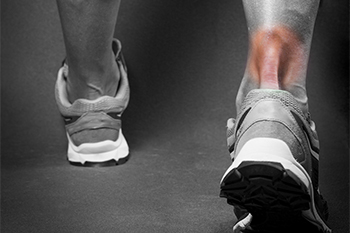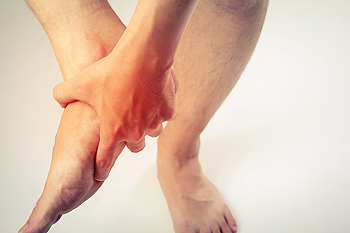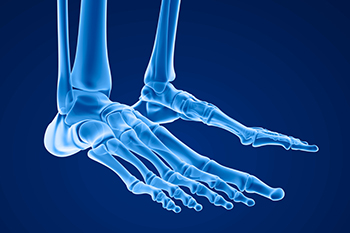Items filtered by date: December 2022
Various Reasons for an Achilles Tendon Injury to Happen

The Achilles tendon is the largest tendon in the body, and it connects the heel to the calf muscles. An Achilles tendon injury can cause severe pain and discomfort, and can happen to anyone. There are specific groups of people who may be prone to developing this type of injury. These can include runners who increase speed and mileage too quickly, or people who have tight or weak calf muscles. Additionally, patients who have feet that naturally roll inward while walking and running may develop an Achilles tendon injury more easily than others. Decreased blood supply in people who are over 30 years old may cause this type of injury to happen, and patients may develop a temporary risk of enduring this condition who frequently take certain antibiotics. If you have pain in the calf that radiates to the heel, you may have this affliction, and it is suggested that you consult with a podiatrist as quickly as possible who can effectively treat you.
Achilles tendon injuries need immediate attention to avoid future complications. If you have any concerns, contact Donald Manger, DPM of Associated Podiatric Physicians, PA. Our doctor can provide the care you need to keep you pain-free and on your feet.
What Is the Achilles Tendon?
The Achilles tendon is a tendon that connects the lower leg muscles and calf to the heel of the foot. It is the strongest tendon in the human body and is essential for making movement possible. Because this tendon is such an integral part of the body, any injuries to it can create immense difficulties and should immediately be presented to a doctor.
What Are the Symptoms of an Achilles Tendon Injury?
There are various types of injuries that can affect the Achilles tendon. The two most common injuries are Achilles tendinitis and ruptures of the tendon.
Achilles Tendinitis Symptoms
- Inflammation
- Dull to severe pain
- Increased blood flow to the tendon
- Thickening of the tendon
Rupture Symptoms
- Extreme pain and swelling in the foot
- Total immobility
Treatment and Prevention
Achilles tendon injuries are diagnosed by a thorough physical evaluation, which can include an MRI. Treatment involves rest, physical therapy, and in some cases, surgery. However, various preventative measures can be taken to avoid these injuries, such as:
- Thorough stretching of the tendon before and after exercise
- Strengthening exercises like calf raises, squats, leg curls, leg extensions, leg raises, lunges, and leg presses
If you have any questions please feel free to contact our office located in Hamilton Township, NJ . We offer the newest diagnostic tools and technology to treat your foot and ankle needs.
How to Spot Plantar Fasciitis

Many people unfamiliar with the field of podiatry might already be familiar with the condition known as plantar fasciitis, because it is one of the most common afflictions of the foot. Plantar fasciitis is typically defined as the inflammation of the plantar fascia, the band of tissue that runs along the sole of the foot. This inflammation can occur for a variety of reasons. However, it is important to be able to recognize signs of plantar fasciitis yourself, in case you develop the condition. Generally speaking, people with plantar fasciitis will experience pains in the feet when first beginning to walk in the morning. Additionally, the pain is typically located in the heels toward the back. Plantar fasciitis also may make certain physical activities uncomfortable or painful, such as walking, running, or engaging in other weight-bearing activities. If you believe that you might have plantar fasciitis, contact a podiatrist today for more information.
Plantar fasciitis can be very painful and inconvenient. If you are experiencing heel pain or symptoms of plantar fasciitis, contact Donald Manger, DPM from Associated Podiatric Physicians, PA. Our doctor can provide the care you need to keep you pain-free and on your feet.
What Is Plantar Fasciitis?
Plantar fasciitis is the inflammation of the thick band of tissue that runs along the bottom of your foot, known as the plantar fascia, and causes mild to severe heel pain.
What Causes Plantar Fasciitis?
- Excessive running
- Non-supportive shoes
- Overpronation
- Repeated stretching and tearing of the plantar fascia
How Can It Be Treated?
- Conservative measures – anti-inflammatories, ice packs, stretching exercises, physical therapy, orthotic devices
- Shockwave therapy – sound waves are sent to the affected area to facilitate healing and are usually used for chronic cases of plantar fasciitis
- Surgery – usually only used as a last resort when all else fails. The plantar fascia can be surgically detached from the heel
While very treatable, plantar fasciitis is definitely not something that should be ignored. Especially in severe cases, speaking to your doctor right away is highly recommended to avoid complications and severe heel pain. Your podiatrist can work with you to provide the appropriate treatment options tailored to your condition.
If you have any questions please feel free to contact our office located in Hamilton Township, NJ . We offer the newest diagnostic and treatment technologies for all your foot and ankle needs.
Plantar Warts Can Be Treated!
Muscles in the Foot

Anyone who wants to care for their feet properly ought to know how the foot functions. Being familiar with the biomechanics of the feet can be greatly informative and beneficial. One important thing to know about the human foot is that it contains different kinds of muscles. There are two different primary kinds of muscles in the foot, the extrinsic and intrinsic muscles. Extrinsic muscles are responsible for movements such as the eversion, plantarflexion, and dorsiflexion of the foot. By contrast, the intrinsic muscles are found on the inside of the foot. This particular kind of foot muscle is responsible for what we call fine motor movements, such as the movement of individual digits, or toes. The muscles of the feet each serve important roles in supporting the feet and protecting them. For more information, contact a podiatrist today.
If you have any concerns about your feet, contact Donald Manger, DPM from Associated Podiatric Physicians, PA. Our doctor can provide the care you need to keep you pain-free and on your feet.
Biomechanics in Podiatry
Podiatric biomechanics is a particular sector of specialty podiatry with licensed practitioners who are trained to diagnose and treat conditions affecting the foot, ankle and lower leg. Biomechanics deals with the forces that act against the body, causing an interference with the biological structures. It focuses on the movement of the ankle, the foot and the forces that interact with them.
A History of Biomechanics
- Biomechanics dates back to the BC era in Egypt where evidence of professional foot care has been recorded.
- In 1974, biomechanics gained a higher profile from the studies of Merton Root, who claimed that by changing or controlling the forces between the ankle and the foot, corrections or conditions could be implemented to gain strength and coordination in the area.
Modern technological improvements are based on past theories and therapeutic processes that provide a better understanding of podiatric concepts for biomechanics. Computers can provide accurate information about the forces and patterns of the feet and lower legs.
Understanding biomechanics of the feet can help improve and eliminate pain, stopping further stress to the foot.
If you have any questions please feel free to contact our office located in Hamilton Township, NJ . We offer the newest diagnostic and treatment technologies for all your foot and ankle needs.
Qualifications to Become a Podiatrist

Podiatrists are medical specialists that treats any type of foot and ankle disorders. People who are interested in practicing this branch of medicine will have to go through an extensive schooling and training program. After a bachelor's degree is obtained, the residency program can begin. This will take approximately three years, and is followed by passing the American Podiatric Medical Licensing Examination. Many states require podiatrists to enroll in a continuing education program sporadically throughout their careers. This is beneficial in keeping up with current knowledge and improved podiatry techniques. Research has shown the best candidates to enter a podiatry residency program will have additional skills in addition to their academic achievements. These can include problem-solving and time management skills, in addition to superb communication skills. This branch of medicine can be lucrative, and provide a sense of accomplishment. If you are interested in pursuing podiatry as a career choice, please seek advice from this type of doctor who can help you to determine if this is a right decision for you.
If you are dealing with pain in your feet and ankles, you may want to seek help from a podiatrist. Feel free to contact Donald Manger, DPM from Associated Podiatric Physicians, PA. Our doctor can provide the care you need to keep you pain-free and on your feet.
What Is a Podiatrist?
A podiatrist is a doctor of podiatric medicine who diagnoses and treats conditions of the foot, ankle, and related structures of the leg. Your podiatrist may specialize in a certain field such as sports medicine, wound care, pediatrics, and diabetic care. Podiatrists have the ability to become board certified through training, clinical experience, and then taking an exam.
What Do Podiatrists Do?
On a daily basis, a podiatrist may perform the following activities:
- Diagnose foot ailments such as ulcers, tumors, fractures, etc.
- Use innovative methods to treat conditions
- Use corrective orthotics, casts, and strappings to correct deformities
- Correct walking patterns and balance
- Provide individual consultations to patients
It is very important that you take care of your feet. It’s easy to take having healthy feet for granted, however foot problems tend to be among the most common health conditions. Podiatrists can help diagnose and treat a variety of feet related conditions, so it is crucial that you visit one if you need assistance.
If you have any questions please feel free to contact our office located in Hamilton Township, NJ . We offer the newest diagnostic and treatment technologies for all your foot and ankle needs.

